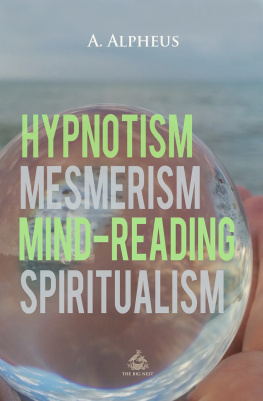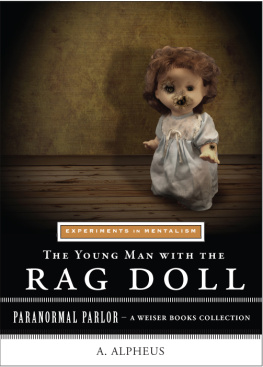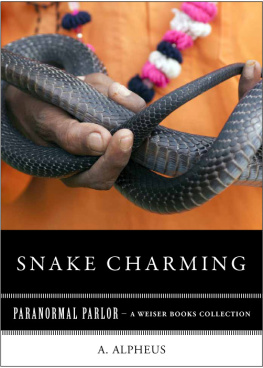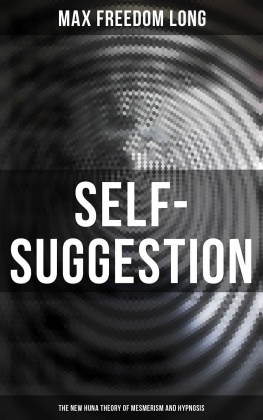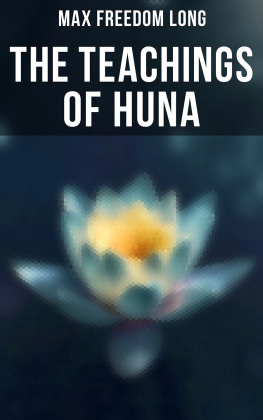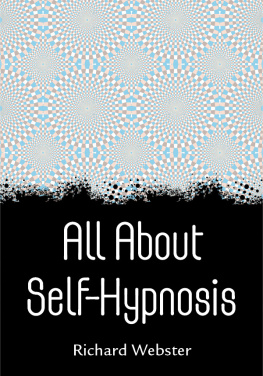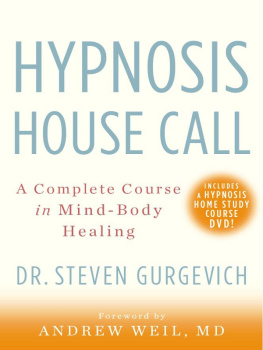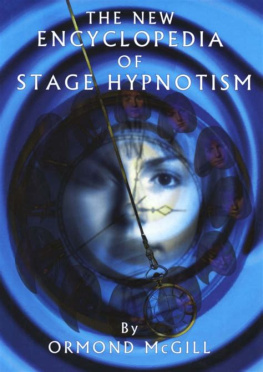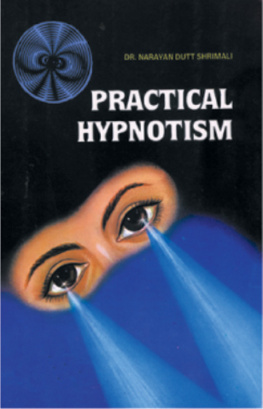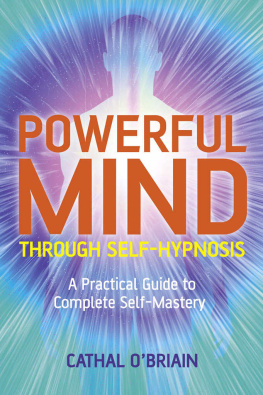A. Alpheus - Hypnotism, Mesmerism, Mind-Reading and Spiritualism
Here you can read online A. Alpheus - Hypnotism, Mesmerism, Mind-Reading and Spiritualism full text of the book (entire story) in english for free. Download pdf and epub, get meaning, cover and reviews about this ebook. year: 2016, publisher: Interactive Media, genre: Religion. Description of the work, (preface) as well as reviews are available. Best literature library LitArk.com created for fans of good reading and offers a wide selection of genres:
Romance novel
Science fiction
Adventure
Detective
Science
History
Home and family
Prose
Art
Politics
Computer
Non-fiction
Religion
Business
Children
Humor
Choose a favorite category and find really read worthwhile books. Enjoy immersion in the world of imagination, feel the emotions of the characters or learn something new for yourself, make an fascinating discovery.
Hypnotism, Mesmerism, Mind-Reading and Spiritualism: summary, description and annotation
We offer to read an annotation, description, summary or preface (depends on what the author of the book "Hypnotism, Mesmerism, Mind-Reading and Spiritualism" wrote himself). If you haven't found the necessary information about the book — write in the comments, we will try to find it.
The book offers an exhaustive and practical system on use of hypnosis, methods and application.
Hypnotism, Mesmerism, Mind-Reading and Spiritualism — read online for free the complete book (whole text) full work
Below is the text of the book, divided by pages. System saving the place of the last page read, allows you to conveniently read the book "Hypnotism, Mesmerism, Mind-Reading and Spiritualism" online for free, without having to search again every time where you left off. Put a bookmark, and you can go to the page where you finished reading at any time.
Font size:
Interval:
Bookmark:
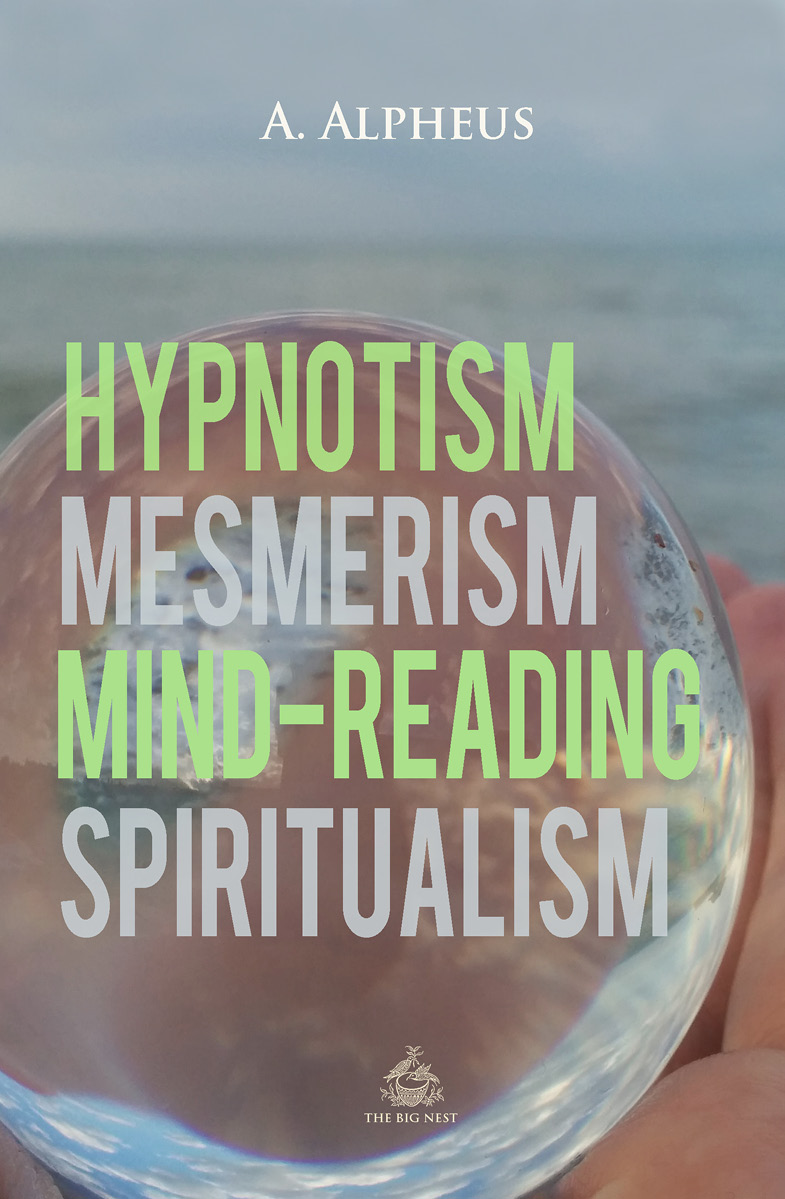
A. Alpheus

A. Alpheus
Hypnotism, Mesmerism,
Mind-Reading and Spiritualism


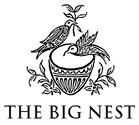
THE BIG NEST
LONDON NEW YORK TORONTO SAO PAULO MOSCOW
PARIS MADRID BERLIN ROME MEXICO CITY MUMBAI SEOUL DOHA
TOKYO SYDNEY CAPE TOWN AUCKLAND BEIJING
New Edition
Published by The Big Nest
www.thebignest.co.uk
This Edition first published in 2016
Copyright 2016 The Big Nest
Images and Illustrations 2016 Stocklibrary.org
All Rights Reserved.
ISBN: 9781911429968
Contents
INTRODUCTION
There is no doubt that hypnotism is a very old subject, though the name was not invented till 1850. In it was wrapped up the mysteries of Isis in Egypt thousands of years ago, and probably it was one of the weapons, if not the chief instrument of operation, of the magi mentioned in the Bible and of the wise men of Babylon and Egypt. Laying on of hands must have been a form of mesmerism, and Greek oracles of Delphi and other places seem to have been delivered by priests or priestesses who went into trances of self-induced hypnotism. It is suspected that the fakirs of India who make trees grow from dry twigs in a few minutes, or transform a rod into a serpent (as Aaron did in Bible history), operate by some form of hypnotism. The people of the East are much more subject to influences of this kind than Western peoples are, and there can be no question that the religious orgies of heathendom were merely a form of that hysteria which is so closely related to the modern phenomenon of hypnotism. Though various scientific men spoke of magnetism, and understood that there was a power of a peculiar kind which one man could exercise over another, it was not until Frederick Anton Mesmer (a doctor of Vienna) appeared in 1775 that the general public gave any special attention to the subject. In the year mentioned, Mesmer sent out a circular letter to various scientific societies or Academies as they are called in Europe, stating his belief that animal magnetism existed, and that through it one man could influence another. No attention was given his letter, except by the Academy of Berlin, which sent him an unfavorable reply.
In 1778 Mesmer was obliged for some unknown reason to leave Vienna, and went to Paris, where he was fortunate in converting to his ideas dEslon, the Comte dArtoiss physician, and one of the medical professors at the Faculty of Medicine. His success was very great; everybody was anxious to be magnetized, and the lucky Viennese doctor was soon obliged to call in assistants. Deleuze, the librarian at the Jardin des Plantes, who has been called the Hippocrates of magnetism, has left the following account of Mesmers experiments:
In the middle of a large room stood an oak tub, four or five feet in diameter and one foot deep. It was closed by a lid made in two pieces, and encased in another tub or bucket. At the bottom of the tub a number of bottles were laid in convergent rows, so that the neck of each bottle turned towards the centre. Other bottles filled with magnetized water tightly corked up were laid in divergent rows with their necks turned outwards. Several rows were thus piled up, and the apparatus was then pronounced to be at high pressure. The tub was filled with water, to which were sometimes added powdered glass and iron filings. There were also some dry tubs, that is, prepared in the same manner, but without any additional water. The lid was perforated to admit of the passage of movable bent rods, which could be applied to the different parts of the patients body. A long rope was also fastened to a ring in the lid, and this the patients placed loosely round their limbs. No disease offensive to the sight was treated, such as sores, or deformities.
A large number of patients were commonly treated at one time. They drew near to each other, touching hands, arms, knees, or feet. The handsomest, youngest, and most robust magnetizers held also an iron rod with which they touched the dilatory or stubborn patients. The rods and ropes had all undergone a preparation and in a very short space of time the patients felt the magnetic influence. The women, being the most easily affected, were almost at once seized with fits of yawning and stretching; their eyes closed, their legs gave way and they seemed to suffocate. In vain did musical glasses and harmonicas resound, the piano and voices re-echo; these supposed aids only seemed to increase the patients convulsive movements. Sardonic laughter, piteous moans and torrents of tears burst forth on all sides. The bodies were thrown back in spasmodic jerks, the respirations sounded like death rattles, the most terrifying symptoms were exhibited. Then suddenly the actors of this strange scene would frantically or rapturously rush towards each other, either rejoicing and embracing or thrusting away their neighbors with every appearance of horror.
Another room was padded and presented another spectacle. There women beat their heads against wadded walls or rolled on the cushion-covered floor, in fits of suffocation. In the midst of this panting, quivering throng, Mesmer, dressed in a lilac coat, moved about, extending a magic wand toward the least suffering, halting in front of the most violently excited and gazing steadily into their eyes, while he held both their hands in his, bringing the middle fingers in immediate contact to establish communication. At another moment he would, by a motion of open hands and extended fingers, operate with the great current, crossing and uncrossing his arms with wonderful rapidity to make the final passes.
Hysterical women and nervous young boys, many of them from the highest ranks of Society, flocked around this wonderful wizard, and incidentally he made a great deal of money. There is little doubt that he started out as a genuine and sincere student of the scientific character of the new power he had indeed discovered; there is also no doubt that he ultimately became little more than a charlatan. There was, of course, no virtue in his prepared rods, nor in his magnetic tubs. At the same time the belief of the people that there was virtue in them was one of the chief means by which he was able to induce hypnotism, as we shall see later. Faith, imagination, and willingness to be hypnotized on the part of the subject are all indispensable to entire success in the practice of this strange art.
In 1779 Mesmer published a pamphlet entitled Memoire sur la decouverte du magnetisme animal, of which Doctor Cocke gives the following summary (his chief claim was that he had discovered a principle which would cure every disease):
He sets forth his conclusions in twenty-seven propositions, of which the substance is as follows:-- There is a reciprocal action and reaction between the planets, the earth and animate nature by means of a constant universal fluid, subject to mechanical laws yet unknown. The animal body is directly affected by the insinuation of this agent into the substance of the nerves. It causes in human bodies properties analogous to those of the magnet, for which reason it is called Animal Magnetism. This magnetism may be communicated to other bodies, may be increased and reflected by mirrors, communicated, propagated, and accumulated, by sound. It may be accumulated, concentrated, and transported. The same rules apply to the opposite virtue. The magnet is susceptible of magnetism and the opposite virtue. The magnet and artificial electricity have, with respect to disease, properties common to a host of other agents presented to us by nature, and if the use of these has been attended by useful results, they are due to animal magnetism. By the aid of magnetism, then, the physician enlightened as to the use of medicine may render its action more perfect, and can provoke and direct salutary crises so as to have them completely under his control.
Font size:
Interval:
Bookmark:
Similar books «Hypnotism, Mesmerism, Mind-Reading and Spiritualism»
Look at similar books to Hypnotism, Mesmerism, Mind-Reading and Spiritualism. We have selected literature similar in name and meaning in the hope of providing readers with more options to find new, interesting, not yet read works.
Discussion, reviews of the book Hypnotism, Mesmerism, Mind-Reading and Spiritualism and just readers' own opinions. Leave your comments, write what you think about the work, its meaning or the main characters. Specify what exactly you liked and what you didn't like, and why you think so.

